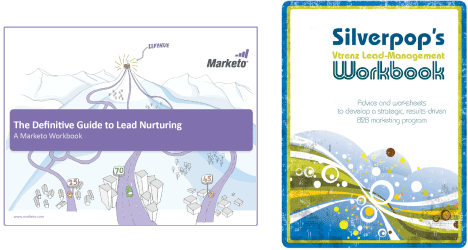Monday and Tuesday I’m attending the Boston MarketingSherpa B2B Marketing Summit. About two weeks ago I attended the San Francisco event, which had a similar program and exhibitors. In this post some thoughts about the program…
First of all, the best thing about this event is that the speakers are marketing practitioners, not vendors. This ensures that you get lots of real-life advice. However, there are also many different perspectives, and it’s not always easy to link them together. But, that can easily be addressed:
Classify the Topics
Having seen many of the presentations in San Francisco, I found it useful to classify them in three main categories:
Lead Generation
Lead Management
Content creation
The first is obviously focused on getting more leads into your database, while the second topic focuses on nurturing those leads. Many marketing organizations now realize that both these activities are more successful if they use attractive content, so that is also addressed in a couple of sessions. I tried to classify every session, and that made it easier for me to distill best practices.
The Review Sessions Are Recommended
I can also recommend the introduction and review sessions led by Flint McGlaughlin, Stefan Tornquist, Sean Donahue and Brian Carroll and of MarketingExperiments, MarketingSherpa and InTouch (all part of the MECLABS group). They do a great job synthesizing all ideas.
Favorite Session
My favorite sessions was presented by Maureen Thorman of National Instruments about customer segmentation based on web traffic: unfortunately this sessions will not be presented in Boston, that’s a bummer.
The Marketing Automation Vendors
My specialty is Marketing Automation Consulting, and many of the vendors were attending with a booth. In Boston the following Marketing Automation vendors are worth a visit (in order of booth number):
Pardot (booth 1)
Manticore Technology (booth 2)
Silverpop Engage B2B (booth 4)
Marketo (booth 6)
Genius.com (booth 7)
Marketbright (booth 14)
Hubspot (booth 16)
Neolane (booth 19)
Twitter & Questions
I will try to tweet as many sessions as possible at the LeadSloth Twitter page. Let me know if you have any questions via Twitter or email (jep leadsloth com). And if you’re attending, let’s connect (see my picture on the right).
 Monday and Tuesday I’m attending the Boston MarketingSherpa B2B Marketing Summit. About two weeks ago I attended the San Francisco event, which had a similar program and exhibitors. In this post some recommendations for the program…
Monday and Tuesday I’m attending the Boston MarketingSherpa B2B Marketing Summit. About two weeks ago I attended the San Francisco event, which had a similar program and exhibitors. In this post some recommendations for the program…
First of all, the best thing about this event is that the speakers are marketing practitioners, not vendors. This ensures that you get lots of real-life advice. However, there are also many different perspectives, and it’s not always easy to link them together. But, that can easily be addressed:
Classify the Topics
Having seen many of the presentations in San Francisco, I found it useful to classify them in three main categories:
- Lead Generation
- Lead Management
- Content creation
The first is obviously focused on getting more leads into your database, while the second topic focuses on nurturing those leads. Many marketing organizations now realize that both these activities are more successful if they use attractive content, so that is also addressed in a couple of sessions. I tried to classify every session, and that made it easier for me to distill best practices.
The Review Sessions Are Recommended
I can also recommend the introduction and review sessions led by Flint McGlaughlin, Stefan Tornquist, Sean Donahue and Brian Carroll and of MarketingExperiments, MarketingSherpa and InTouch (all part of the MECLABS group). They do a great job synthesizing all ideas.
My Favorite Session
My favorite session in San Francisco was presented by Maureen Thorman of National Instruments about customer segmentation based on web traffic: unfortunately this sessions will not be presented in Boston, that’s a bummer, because they used very advanced web analytics to improve the conversation with prospects and customers.
The Marketing Automation Vendors
My specialty is Marketing Automation Consulting, and many of the Marketing Automation vendors have a booth. In Boston you should definitely stop by at the booths of the following Marketing Automation vendors (in order of booth number):
Twitter & Questions
I will try to tweet as many sessions as possible at the LeadSloth Twitter page. Let me know if you have any questions via Twitter or email (jep leadsloth com). And if you’re attending, let’s connect (see my picture on the right)!

 Hubspot Show & Tell
Hubspot Show & Tell
 The full title of this event is “Lead Management: Tackling the Top 5 Questions about the Lead Cultivation, Qualification and Hand-Off Process”. It’s presented by Sean Donahue, Editor, MarketingSherpa and Jennifer Horton, Best Practices Consultant, Eloqua. During the webinar, they will cover practical strategies that highlight the best way to attract new leads, how to find the right approach for the type and timing of messages, and when to complete the transition to sales.
The full title of this event is “Lead Management: Tackling the Top 5 Questions about the Lead Cultivation, Qualification and Hand-Off Process”. It’s presented by Sean Donahue, Editor, MarketingSherpa and Jennifer Horton, Best Practices Consultant, Eloqua. During the webinar, they will cover practical strategies that highlight the best way to attract new leads, how to find the right approach for the type and timing of messages, and when to complete the transition to sales. Monday and Tuesday I’m attending the Boston
Monday and Tuesday I’m attending the Boston 